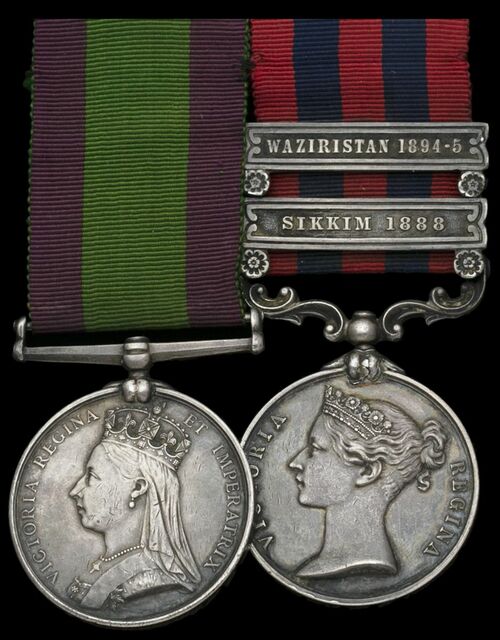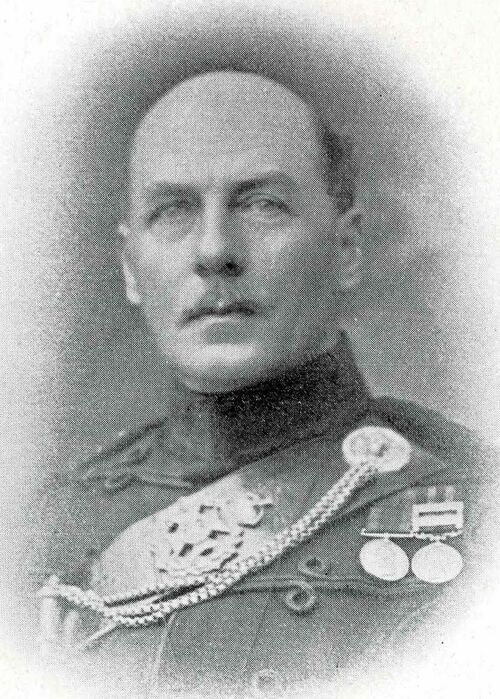Auction: 23003 - Orders, Decorations and Medals
Lot: 71
Pair: Colonel G. S. Ommanney, 9th (Norfolk) Regiment of Foot, latterly 2/1st & 3rd Gurkha Rifles, who was 'mentioned' for his part in the Second Afghan War
Afghanistan 1878-80, no clasp (2d. Lieut. G. S. Ommanney 2d. Bn. Norfolk Regt. (9th Foot)); India General Service 1854-95, 2 clasps, Sikkim 1888, Waziristan 1894-5 (Lieutt. & Offgt. Wing Commr. G. S. Ommanney 2d. Bn. 1st Goorkha Rifles.), mounted as worn by Hunt & Roskell, last with suspension re-affixed, very fine (2)
George Stewart Ommanney commanded the 2nd Battalion, 3rd Queen Alexandra's Own Gurkha Rifles (2/3GR) from 1903-10 and died in 1918, in the knowledge that a soldier of his Battalion had become the first Gurkha to be awarded the Victoria Cross.
Ommaney was born on 18 November 1859, the son of Colonel Edward Lacon Ommanney, Bengal Army's Corps of Engineers (who had been present at the siege of Delhi 1857), and baptised in Lahore the following year. Educated at Haileybury College, he went up to Sandhurst and was commissioned into the 9th Foot (East Norfolk) on 1 May 1878, joining the 2nd Battalion, raised in 1858, which had sailed to India in 1874 and was stationed in Peshawar.
On the outbreak of the Second Afghan War, the 2nd Battalion, 9th Foot was held in Reserve, although two Companies were sent to Jamrud to reinforce the Garrison, from where they were employed in convoy protection between Jamrud and Ali Masjid, repeatedly having to beat off enemy attacks. On the resumption of the War in September 1879, the 2nd Battalion was assigned to the 1st Brigade, but before it could enter the Khyber Pass, cholera broke out within the Battalion and it was placed in temporary quarantine. It subsequently rejoined the force that marched to the relief of General Roberts' force at Sherpur, which it reached on 24th December. The Battalion occupied the Royal Square in the Bala Hassar for the next three month, tasked with providing working parties to level-out the centre and constructing and repairing neighbouring roads. On the evacuation of Kabul in July 1880, following the despatch of General Robert's column to Kandahar, the 2nd Battalion was the last regiment to leave Sherpur. It formed part of the rear guard for General Stewart's force, reaching Jamrud in early September 1880 after a severe and harassing march. Ommanney is recoded by Sydney H. Shadbolt as having served with the Battalion during the war, taking part in the advance to Kabul in December, 1879. He was one of five officers of the Battalion to also be Mentioned in Despatches.
The 9th Foot (East Norfolk) was re-designated The Norfolk Regiment in 1881, as part of the Caldwell Army Reforms. During this period, the 2nd Battalion was stationed in Subathoo, Bengal with Lieutenant Ommanney designated the Station Staff Officer. On 15 September 1882, he transferred to the 10th Bengal Native Infantry (late 65th Native Infantry, raised in 1823 and which had been disarmed but not mutinied in 1857-8), and appointed a Wing Officer, Quartermaster and Officiating Adjutant.
In February 1886, the 1st Goorkha Light Infantry was authorised to raise a second Battalion in Dharmsala and Ommanney transferred across from 10th Bengal Native Infantry in the appointment as a Wing officer and Quartermaster on 19 February 1886. Two years later, in August 1888, the 2nd Battalion was ordered to reinforce the Sikkim Expeditionary Force, which was facing a threatening Tibetan force that occupied one of the high altitude passes that crossed over into Tibet, but in Sikkim territory. In late September, the Sikkim Expeditionary Force took offensive action to eject the Tibetans from Sikkim. The main column, comprising the 2nd Battalion, with an advance guard Commanded by Ommanney, and elements of the Derbyshire Regiment, was tasked to assault the right of the Tibetan position. Tibetan resistance quickly collapsed, which allowed the Sikkim Expeditionary Force to re-occupy Sikkim territory up to the border with Tibet. With active operations at an end, the majority of the Force was withdrawn leaving the 2nd Battalion in Sikkim until it received orders in August 1889 to return to Dharmsala (Medal & clasp).
Promoted Captain on 1 May 1889, he was cross-posted to the 1st Battalion as a Wing Commander on 1 September 1894 and formed part of the escort to the Waziristan Delimitation Commission, which was attacked at Wana by Mahsud Waziris at dawn on 3 November 1894. The Battalion was astride the main axis of the attack and bore the brunt of the assault. The attack eventually petered out and the rebel tribesmen withdrew. The escort suffered 120 casualties, over half of whom were from the 1st Battalion. It was the Regiment's highest number of operational casualties since being raised in 1815. The 1st Battalion subsequently took part in the punitive expedition against the Mahsuds (clasp).
Promoted Major 1 May 1898, Ommanney was posted back to the 2nd Battalion and appointed Second-in-Command and a Double Company Commander on 10 November 1900. Nearly three years later, on 16 May 1903, he was appointed to command the 2nd Battalion, 3rd Gurkha Rifles and promoted to Lieutenant-Colonel on 1 May 1904; and Brevet Colonel on 1 May 1907. Despite most of his Gurkha service being with 1st Gurkha Rifles, the Regimental History records that: from the moment he took up his command until the day he departed (in 1910), the zeal and enthusiasm that he adopted the 3rd Gurkhas as his own was remarkable. Soon after joining he originated the idea of the 'Ahmed Khel Day' and an inter-battalion musketry competition.
Upon retirement, in 1910, he settled in Kensington, London, with his third wife, Amelie (Lili), née Pemberton; his previous two wives having died in Lansdowne, the home station of the 2nd Battalion, 3rd Gurkha Rifles, in 1906 and 1909 respectively. On the outbreak of the Great War he was recalled and commanded the 58th Battalion Training Reserve until his death on 21 March 1918. He was buried in Brompton Cemetery and his death is recorded on the Indian Army panel in the Royal Memorial Chapel, Royal Military Academy, Sandhurst.
Subject to 20% VAT on Buyer’s Premium. For more information please view Terms and Conditions for Buyers.
Sold for
£520
Starting price
£320







